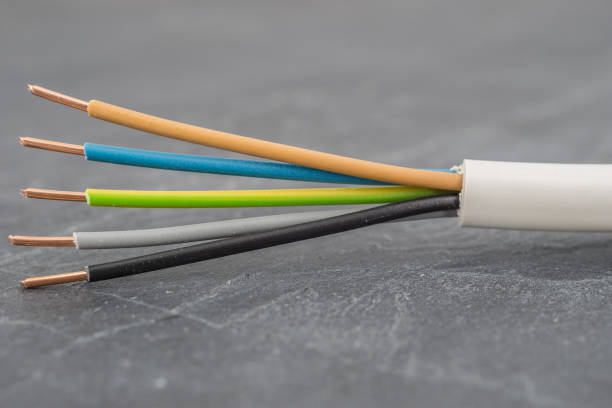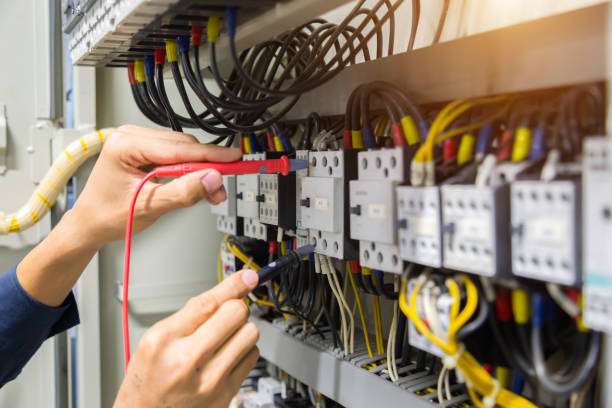Did you know that the wires and cables in your home do more than just keep the lights on? At Ferezco Power Systems, we know how important it is to use the right kind of wire for every job.
Whether you’re hanging a new light, setting up your game console, or making sure your home is as safe as it can be, choosing the right wire makes all the difference. In this post, we’ll show you the different types of electrical wires and cables, explain what each type is used for, and help you make smart choices for all your electrical projects.
Let’s make sure your home is powered safely and efficiently!
Single Conductor Wires

Single conductor wires are the most basic type of electrical wire, consisting of a single wire conductor, usually made of copper or aluminum, which is known for its excellent electrical conductivity and flexibility. This conductor is encased in a protective insulation layer that guards against the dangers of short circuits and electrical fires.
Color Coding and Its Importance
One of the key features of single conductor wires is their color coding, which adheres to the National Electrical Code (NEC) standards. This color coding is not just for aesthetic purposes but serves a crucial safety function by indicating the wire’s purpose within the electrical system:
- Black wires are hot wires, used to carry power from the source to the destination. They are typically used in switches, outlets, and other power supplies.
- Red wires serve a similar purpose to black wires but are usually used for installations that require a second phase of voltage, such as a 220-volt outlet or when wiring a ceiling fan with a light.
- White wires are neutral wires, which complete the circuit by carrying the current back to the electrical panel. They are crucial for the safe operation of the power system.
- Green or bare copper wires are used for grounding. They protect the system from electrical surges and faults by directing excess electricity away from the sensitive components of your home’s electrical system and into the ground.
Related: What Is a Ground Wire, and Why Is It Important?
Applications of Single Conductor Wires
Single conductor wires are versatile and used in various applications, from residential wiring to commercial and industrial settings. In homes, they are often used to connect light fixtures, outlets, and switches to the main power supply. In commercial setups, these wires can be found in the internal wiring of devices or running power to units that require a dedicated energy source.
Safety Tips
When working with single conductor wires, it’s important to ensure you’re using the correct wire gauge and type for the specific application to prevent overheating and potential fires. Here are a few tips:
- Always check the amperage rating of the wire compared to the load it will carry. This information can usually be found on the wire’s insulation.
- Never use a wire that is not rated for both the voltage and the environment of its application. Outdoor or underground installations often require wires with special insulation.
- Follow local building codes and standards, which may vary by location and type of installation.
Multi-Conductor Cables

Multi-conductor cables are like the big brothers to single wires. Instead of just one wire inside, they have multiple insulated wires bundled together inside a single cable. This makes them perfect for powering complex devices or systems from one point to another, all while keeping your setup neat and organized.
Structure and Composition
Each wire inside a multi-conductor cable is usually made of copper or aluminum and is coated with its own layer of insulation. The whole bundle is then wrapped in an outer jacket for extra protection. This design helps prevent electrical interference and protects the wires from environmental damage.
Common Uses in Everyday Life
- Home Appliances: Your dishwasher, refrigerator, and washing machine all use multi-conductor cables to handle multiple electrical tasks at once.
- Office Equipment: Computers, printers, and copiers are powered using these cables, ensuring that data and power can flow smoothly and reliably.
- Entertainment Systems: Home theaters and gaming setups often require several types of signals to be transmitted simultaneously, making multi-conductor cables a necessity for a clutter-free entertainment area.
Related: How to Upgrade Your Home to 220 Volt Service
Benefits of Multi-Conductor Cables
One of the biggest advantages of using multi-conductor cables is convenience. With multiple wires in one cable, you can reduce clutter and simplify the installation process. They also enhance safety by keeping live, neutral, and ground wires compactly organized, reducing the risk of electrical accidents.
Choosing the Right Multi-Conductor Cable
Choosing the right cable depends on the job it needs to do:
- Check the Voltage and Current Requirements: Make sure the cable can handle the electrical load of the device or system.
- Understand the Environment: If the cable will be used outdoors or in harsh conditions, it needs to be durable enough to withstand the elements.
- Consider the Length: Longer cables can reduce the effectiveness of the signal transmission, so it’s important to use the right length for your needs.
Specialty Cables and Their Uses
When we talk about powering up our gadgets, lighting our homes, or setting up a security system, not just any wire will do the trick. Here at Ferezco Power Systems in San Antonio, we like to match the perfect cable to the job it’s meant for. This is where specialty cables come into play. They are designed for specific tasks that regular cables just can’t handle. Let’s explore some of these specialty cables and what makes them so special.
1. Coaxial Cables
You’ve probably used coaxial cables at home without even knowing it—they are commonly used to connect your TV to the cable service. These cables are built with a core inner conductor, usually copper, surrounded by an insulating layer and another conducting shield. The design helps block out interference from radios, electrical equipment, and other sources of electromagnetic noise. This makes coaxial cables perfect for delivering clear video and audio signals.
2. Twisted Pair Cables
These are the unsung heroes in the walls of your home and office. Twisted pair cables consist of pairs of wires twisted around each other. Why the twist? It cancels out electromagnetic interference from external sources and cross-talk from nearby wires, which is great for maintaining a clear signal. You’ll find twisted pair cables in networking for computers and in telephone systems where maintaining signal integrity over long distances is crucial.
3. Fiber Optic Cables
Imagine sending light signals across thin strands of glass or plastic—that’s exactly what fiber optic cables do. These cables can transmit a massive amount of data at very high speeds over great distances. Because they use light instead of electrical signals, they are immune to many types of interference, making them ideal for high-speed internet connections, cable television, and telecommunications.
4. USB Cables
Almost everyone has used a USB cable to charge a phone or connect a device to a computer. USB (Universal Serial Bus) cables are designed to standardize connections between devices and computers, providing a pathway for both power and data. What makes them special is their versatility and ease of use, which have made them a cornerstone of modern electronic connectivity.
5. Fire Alarm Cables
Safety comes first, and that’s where fire alarm cables come in. These cables are specifically designed to withstand extreme conditions and continue operating during a fire. They connect fire alarms, smoke detectors, and other critical safety equipment to ensure that, in the event of a fire, the alarm systems function properly to alert occupants and guide them to safety.
Related: Types of Electrical Wire for Residential Buildings
Difference Between Wire and Cable
When setting up electrical systems at home or in the office, you’ll come across two terms a lot: wires and cables. It might seem like they’re just two ways of saying the same thing, but at Ferezco Power Systems in San Antonio, we know there’s a big difference. Understanding these can help you choose the right one for your project, making sure everything works safely and efficiently.
What’s a Wire?
A wire is a single conductor, usually made of metal like copper or aluminum, that carries electricity. It’s often surrounded by insulation, a protective layer that prevents the wire from touching other wires or surfaces and causing a short circuit. Wires are simple and straightforward. They’re used in a lot of basic electrical setups, like wiring a simple light switch or connecting a lamp to your home’s power system.
What’s a Cable?
A cable, on the other hand, is a bunch of wires wrapped together in one sheath. This bundle not only helps in managing the installation by keeping everything tidy but also improves safety by protecting the wires inside from external damage. Cables can carry multiple signals at once, which makes them perfect for more complex systems like your home entertainment center or your office’s computer network.
Key Differences
Here are a few key points that show the differences between wires and cables:
- Number of Conductors: Wires are single conductors, while cables are made up of multiple wires.
- Protection: Wires usually have just their insulation, but cables have an additional layer of protection thanks to their outer sheath.
- Usage: Wires are great for simple, straightforward tasks. Cables, because they can handle multiple tasks at once, are better suited for bigger, more complicated setups.
Choosing the Right Option
Knowing whether you need a wire or a cable depends on what you’re trying to do:
- If you’re doing something simple, like setting up a light, a wire might be all you need.
- If you’re looking to set up something that involves multiple connections, like a home theater, then a cable will help you keep everything organized and safe.
At Ferezco Power Systems, we stock a wide variety of both wires and cables, each suited for different types of jobs. Not sure what to get? Just ask us! We’re here to help you figure out exactly what you need for your project.
Why Trust Ferezco Power Systems?
We’re not just another hardware store, we’re your local San Antonio experts in electrical systems. We provide top-quality products and real-world advice, whether you’re installing a new ceiling fan or wiring a commercial building. With Ferezco Power Systems, you get the confidence of knowing you’ve chosen the right materials for a successful project.
In conclusion, choosing the right type of wire or cable is crucial for the success and safety of your electrical projects. By understanding the basics, reading the ratings, considering the application, and adhering to safety standards, you can ensure your projects run smoothly. Remember, the right choice leads to the best performance.




